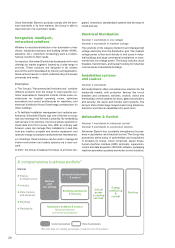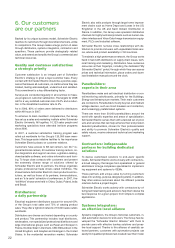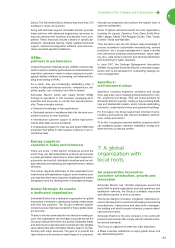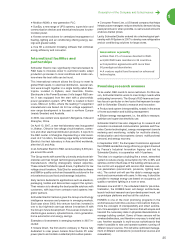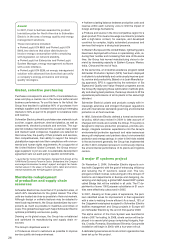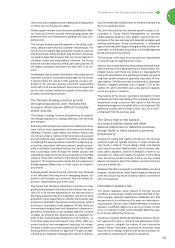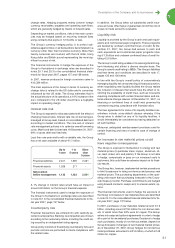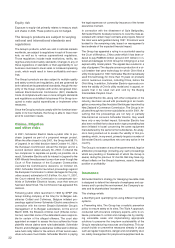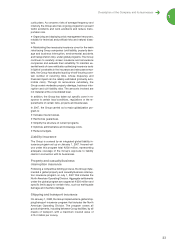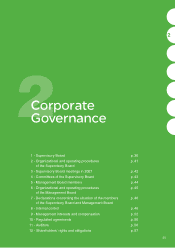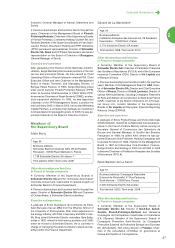APC 2007 Annual Report Download - page 32
Download and view the complete annual report
Please find page 32 of the 2007 APC annual report below. You can navigate through the pages in the report by either clicking on the pages listed below, or by using the keyword search tool below to find specific information within the annual report.30
Problems may also be encountered during the deployment
of new applications or software. In particular, a project was
launched in 2005 to design, develop and build a Group-
wide SAP-based ERP system. The initial vision and de-
tailed design phases were completed in July 2005 and the
core system is now being built, for deployment on several
pilot sites over the period 2007-2009. Once the trial phase
has been completed at the end of 2009, the system will be
rolled out to the entire Group over a period of around four
years.
In view of the project’s complexity, extensive functionalities
and its worldwide deployment, a dedicated governance
and cost control structure has been set up to track attain-
ment of project milestones and limit the related risks.
However, despite the Group’s policy of establishing gover-
nance structures and contingency plans, there can be no
assurance that information systems projects will not be
subject to technical problems or execution delays. While it
is difficult to accurately quantify the impact of any such
problems or delays, they could have an adverse effect on
inventory levels, service quality and – consequently – the
Group’s financial results.
The Group is dependent upon hiring
and retaining highly qualified management
and technical personnel
Competition for highly qualified management and technical
personnel is intense in the Group’s industry. Its future suc-
cess depends in part on the Group’s ability to hire, assim-
ilate and retain engineers and other qualified personnel.
The Group’s human resources strategy is designed to cre-
ate a motivating working environment. Specific policies
have been developed covering international mobility, ca-
reer development, training and compensation. The Group’s
expatriates help it prepare the future of its business, build
local teams and assemble the necessary skill-sets in tar-
geted regions. The Group places considerable emphasis
on training to deepen its skills base and retain employees.
The development and success of
the Group’s products depends on its ability
to protect its intellectual property against
competitors
The Group’s future success depends to a significant ex-
tent on the development and maintenance of its intellec-
tual property rights. Third parties may infringe the Group’s
intellectual property rights, and the Group may expend sig-
nificant resources monitoring, protecting and enforcing its
rights. If the Group fails to protect or enforce its intellectual
property rights, its competitive position could suffer, which
could have an adverse effect on its business.
In order to mitigate this risk, the patents developed or pur-
chased by the Group are tracked by the Industrial Prop-
erty team within the Finance & Control - Legal Affairs
Department. All industrial property information for the main
Group subsidiaries is transmitted to this team, which is re-
sponsible for managing and protecting these intangible as-
sets throughout the world. The same procedure is followed
for trademarks.
In 2005, the Group decided to combat violations of indus-
trial property rights more vigorously, taking legal action
against patent counterfeiters in Germany, Italy, France and
other jurisdictions.
The Group’s plants and products
are subject to environmental regulations
The Group’s plants and products are subject to extensive
and increasingly stringent environmental laws and regula-
tions in all of its host countries.
In order to limit risks related to the environment generally,
the Group is involved in a process to continuously improve
the environmental performance of its plants and products.
In 1992, the Group published a formal environmental pol-
icy, which was recently redefined to take account of
changes both inside and outside Schneider Electric.
T
he policy is designed to improve manufacturing processes,
promote eco-design and integrate customer concerns
in the area of environmental protection. It also aims to
identify, assess and prevent environmental risks, in
order to guarantee full compliance with all environmen-
tal laws and regulations applicable to the Group’s busi-
nesses. Environmental provisions are booked when the
risks can be reliably measured or it is probable that
clean-up work will be performed and the related cost
can reasonably be estimated. No estimate is made of
the potential cost of unidentified environmental risks.
The Group expects its spending on environmental com-
pliance programs to increase as a result of changes to
existing environmental regulations and the introduction
of new regulations.
There can be no guarantee that the Group will not be re-
quired to pay significant fines or compensation as a result
of past, current or future breaches of environmental laws
and regulations by companies that are currently or were
previously members of the Group. This exposure exists
even if the Group is not responsible for the breaches, in
cases where they were committed in the past by compa-
nies or businesses that were not part of the Group at the
time.
The Group may be exposed to the risk of claims for
breaches of environmental laws and regulations. Such
claims could adversely affect the Group’s financial position
and reputation, despite the efforts and investments made
to comply at all times with all applicable environmental laws
and regulations.
If the Group fails to conduct its businesses in full compli-
ance with the applicable environmental laws and regula-
tions, the judicial or regulatory authorities could require the
Group to conduct investigations and/or implement costly
clean-up measures to deal with the current or past con-
tamination of current or former facilities or off-site waste
disposal facilities, and to scale-back or temporarily or per-
manently close facilities in accordance with the applicable
environmental laws and regulations.
The Group’s international operations
expose it to the risk of fluctuations in
foreign exchange rates
Because a significant proportion of transactions are de-
nominated in currencies other than the euro, the Group is
exposed to risk arising from changes in exchange rates. If
the Group is not able to hedge them, fluctuations in ex-
change rates between the euro and these currencies can
have a significant impact on its results of operations and
distort year-on-year performance comparisons.
The Group actively manages its exposure to currency risk
to reduce the sensitivity of earnings to changes in ex-


